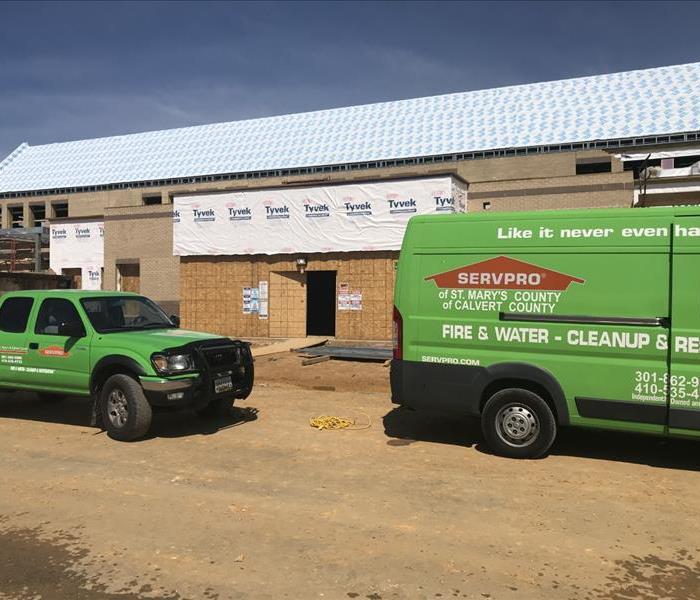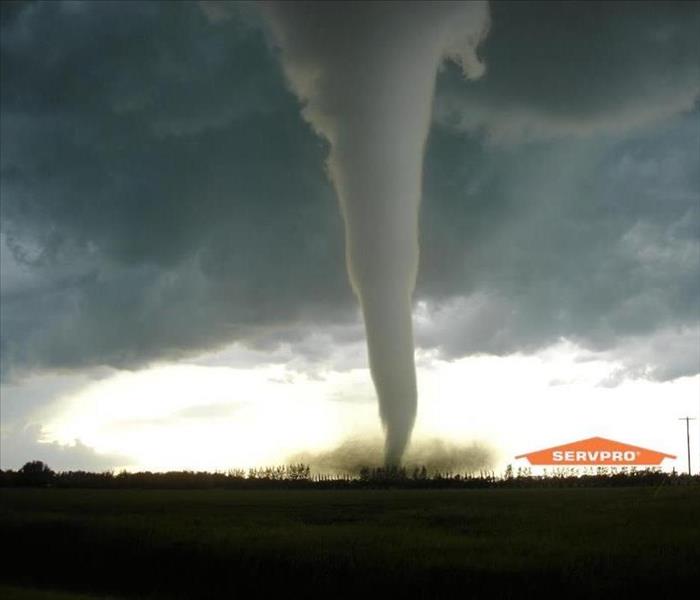Recent Storm Damage Posts
The Importance of Immediate Action After California Flood Damage
12/3/2024 (Permalink)
 SERVPRO's swift arrival and service can mitigate flood damage to your California property. We're Faster to any size disaster.™
SERVPRO's swift arrival and service can mitigate flood damage to your California property. We're Faster to any size disaster.™
How to Minimize Water Damage Through Rapid Restoration
Floodwater can cause heavy damage to your home, causing immediate destruction and long-term complications if not addressed when water seeps into walls, floors, and belongings; every minute counts. Acting quickly after a flood protects your property and safeguards your health and finances.
Why Time Is Critical After a Flood in Your Home
Floodwater can rapidly compromise every aspect of your home. In the first 24-48 hours, flood damage in California homes begins to warp wood, corrode metals, and deteriorate drywall. If left untreated, mold spores thrive in damp environments, spreading quickly and creating additional hazards. Mold growth damages materials further and poses health risks for specific individuals.
Delaying restoration also increases costs. What begins as a manageable cleanup can escalate into expensive repairs or even replacement of major components of your home. Additionally, many insurance policies require prompt action to cover flood damage claims fully.
Steps to Take After Flood Damage
- Ensure Safety First: Avoid entering flooded areas until professionals confirm Safety. Floodwater can contain contaminants, and standing water may conceal electrical hazards.
- Document the Flood Damage: Take photos or videos of the affected areas for insurance.
- Call Professional Restoration Services: A company like SERVPRO® has the expertise and equipment to begin the drying and restoration process immediately. From water extraction to sanitization and mold prevention, professionals ensure your home is restored effectively.
How SERVPRO Helps You Recover
At SERVPRO, we understand the urgency of flood damage restoration. Our IICRC-trained technicians are available 24/7 to respond quickly, assess the damage, and create a tailored plan to restore your home. Using advanced equipment, we remove water, dry affected areas, and treat for mold to prevent further issues.
Don't let flood damage jeopardize your home and health. Call SERVPRO of St. Mary's County today to start the recovery process. With our professional restoration services, we'll make your home "Like it never even happened."
Storm Flood Damage Repair in California Homes Is Better with SERVPRO
5/6/2024 (Permalink)
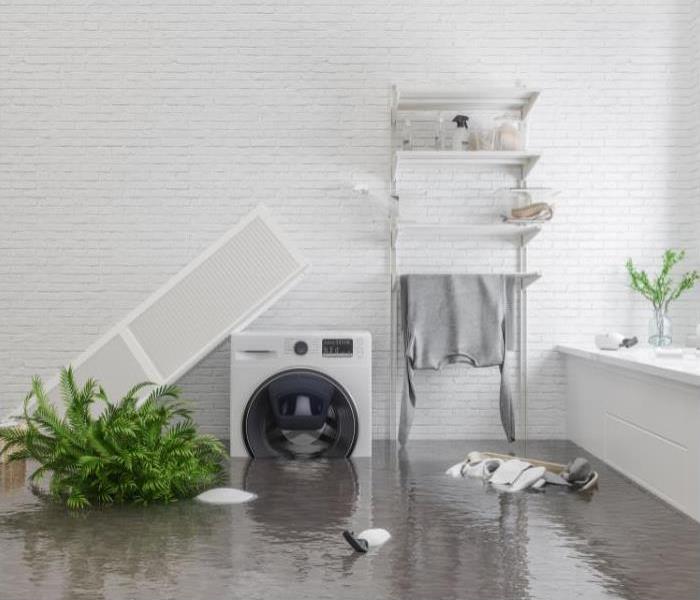 SERVPRO handles storm flood damage in California with precision and expertise. From inspection to reconstruction, trust the experts.
SERVPRO handles storm flood damage in California with precision and expertise. From inspection to reconstruction, trust the experts.
How to Handle Storm Flood Damage in California
I have flood damage in my home following a storm. How can I restore my property to normal? A professional remediation provider can assist you in restoring your residence.
Storm floodwater can quickly inundate your residence through the basement, roof, doors, and windows. SERVPRO understands the delicate position when dealing with storm flood damage in your California property. We provide cost-effective and comprehensive flood damage repair services. The steps for successful flood damage repair include:
- Inspection
- Water extraction and drying
- Cleaning and sanitizing
- Deodorization
- Reconstruction
Inspection
An extensive inspection is a crucial part of storm flood damage repair. Our SERVPRO technicians can inspect everything in your home or possible flood damage. We have the tools required to properly detect the extent of flood damage, including moisture meters, moisture sensors, and thermal imaging cameras.
Water extraction and drying
SERVPRO’s professional team can use pumps to extract the floodwater. High humidity in a home can be as damaging as standing water. We can position air movers to deliver fast airflow to damp surfaces, increasing evaporation at the surface level. We can use dehumidifiers to blow dry, warm air into the affected areas.
Cleaning and sanitizing
Floodwaters have several dangerous contaminants and a lot of mud. High-dollar items like electronics can get ruined at once, even with an inch of water. A deeper flood can add damage to costlier systems like heaters and air conditioners, ducts, utilities, well systems, roofing, and the foundation. We can clean the entire area properly and sanitize it using EPA-registered disinfectants.
Deodorization
We can use different deodorization methods to deal with flood damage odors. An example is dispensing solvent-based and water-based deodorizers using ULV foggers. The foggers generate tiny particles or deodorants that penetrate many areas odor particles hide.
Reconstruction
This stage involves repairing walls, pipes, electrical appliances, and floors, among other areas in the house. Our SERVPRO technicians can reconstruct your property to return it to its normal condition or better. We may suggest third-party specialists.
SERVPRO of St. Mary's County is a premier company that offers storm flood damage repairs. Do not hesitate to contact us at (301) 862-9500 for repairs.
Having a plan for when serve storms strike.
12/28/2021 (Permalink)
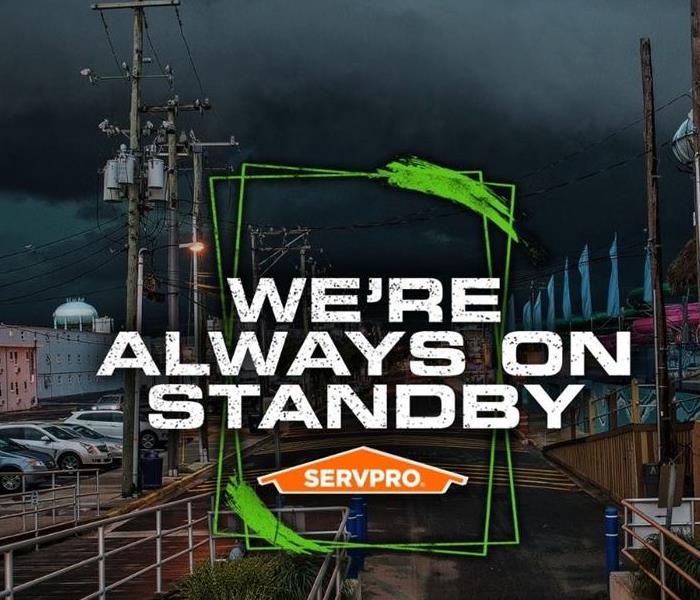 We are here to help.
We are here to help.
Storms can bring devastation to our area. It is always important for you and your family to have a plan for when devastating storms are coming.
- Write down emergency phone numbers and keep them on the refrigerator or near every phone in your house.
- Prepare an supply kit
- Locate the nearest shelter and different routes you can take to get there from your home.
- Pet owners: Pre-identify shelters, a pet-friendly hotel, or an out-of-town friend or relative where you can take your pets in an evacuation.
Gather emergency supplies.
During and after a storm, you may need supplies to keep your family safe and healthy. Remember that a storm could cut off your power and water supply. You also may not be able to drive because of damage to your car. Roads may be flooded or blocked.
That’s why it’s best to be prepared—stock up on everything you might need now. Be sure to prepare the following:
- Food and Water.
- Medical supply
- Emergency power (Generators)
- Medical documents, wills, passports, and personal identification.
- A fire extinguisher. Make sure your family knows where to find it and how to use it!
Get your car ready.
Make sure your car is ready before the storm hits.
- Fill your car’s gas tank.
- Move cars and trucks into your garage or under cover.
- Always keep an emergency kit in your car.
If you don’t own a car, consider making plans with friends or family or call authorities to get a ride if you need to evacuate.
Get your home ready.
- Clear your yard. Make sure there’s nothing that could blow around during the storm and damage your home. Move bikes, lawn furniture, grills, propane tanks, and building material inside or under shelter.
- Cover up windows and doors. Use storm shutters or nail pieces of plywood to the outside window frames to protect your windows. This can help keep you safe from pieces of shattered glass.
- Be ready to turn off your power. If you see flooding, downed power lines, or you have to leave your home, switch your power off.
- Fill clean water containers with drinking water. You’ll want to do this in case you lose your water supply during the storm. You can also fill up your sinks and bathtubs with water for washing.
- Check your carbon monoxide (CO) detector’s battery
Be ready to evacuate or stay at home.
Always listen to authorities regarding whether you should evacuate or stay at home.
If a storm is coming, you may hear an order from authorities to evacuate (leave your home). Never ignore an order to evacuate. Even sturdy, well-built houses may not hold up against a serve storm. Staying home to protect your property is not worth risking your health and safety.
You may hear an order to stay at home. If driving conditions are dangerous, staying at home might be safer than leaving.
- Keep your emergency supply kit in a place you can easily access.
- Listen to the radio or TV for updates on the storm
- Stay inside. Even if it looks calm, don’t go outside. Wait until you hear or see an official message that the hurricane is over. Sometimes, weather gets calm in the middle of a storm but then quickly gets bad again.
- Stay away from windows—you could get hurt by pieces of broken glass or flying debris during a storm. Stay in a room with no windows, or go inside a closet.
- Be ready to leave. If emergency authorities order you to leave or if your home is damaged, you may need to go to a shelter or a neighbor’s house.
Remember we are always here to help. Give us a call if you suffer from storm damage.
When Storms or Floods hit St. Mary's and Calvert Counties, SERVPRO is ready!
12/8/2021 (Permalink)
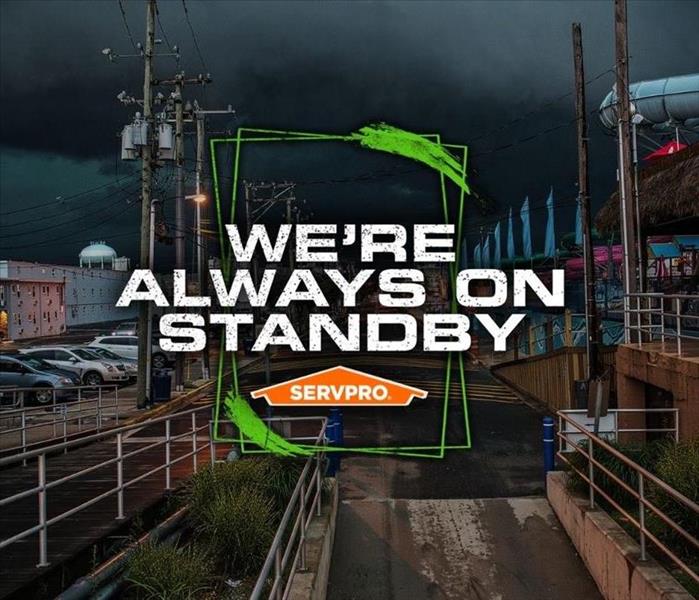 SERVPRO of St. Mary's and Calvert Counties is always ready for whatever happens.
SERVPRO of St. Mary's and Calvert Counties is always ready for whatever happens.
SERVPRO ofSt. Mary's and Calvert counties specializes in storm and flood damage restoration. Our crews are highly trained and we use specialized equipment to restore your property to its pre-storm condition.
Faster Response
Since we are locally owned and operated, we are able to respond quicker with the right resources, which is extremely important. A fast response lessens the damage, limits further damage, and reduces the restoration cost.
Resources to Handle Floods and Storms
When storms hit St. Mary's and Calvert counties, we can scale our resources to handle a large storm or flooding disaster. We can access equipment and personnel from a network of 1,650 Franchises across the country and elite Disaster Recovery Teams https://www.SERVPROstmarysandcalvert.com/storm-flooding-restoration that are strategically located throughout the United States.
Have Storm or Flood Damage? Call Us Today 301-862-9500
Generator Safety
11/17/2021 (Permalink)
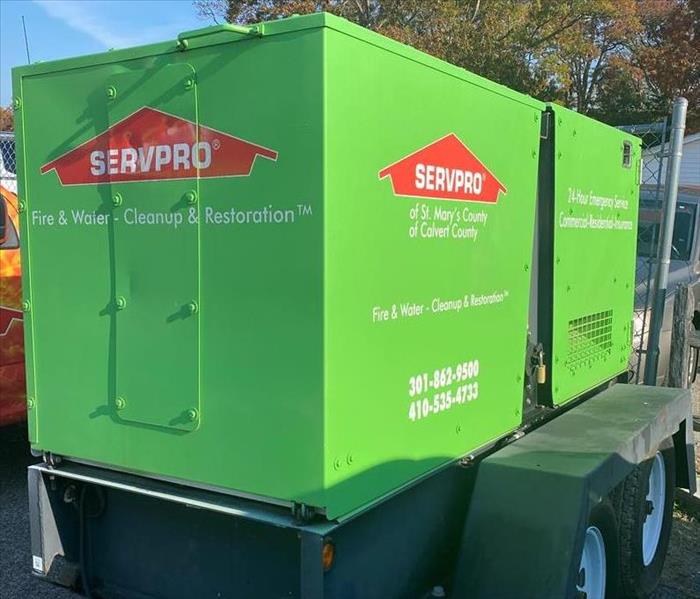 Generator Safety
Generator Safety
After a large storm it is common to have power loss if your powerlines were effected. A way to combat this is to have an emergency or portable generator to give your home some temporary power. while using these generators here are some basic rules to follow.
- Keep generators outdoors and away from any structure. Generators put off large amounts of carbon monoxide which can be fatal.
- Turn generator off and allow for it to cool before refueling. Any fuel that spills to hot parts of the engine could cause a fire.
- Don't run generator in the rain. Best to keep dry to prevent any issues that may occur from water entering your generator.
- Keep extra fuel on hand. It is important to understand how fast your generator runs through fuel so you don't run out.
- Don't plug into your home. Generators are not designed to power your house, this is known as back feeding. If you plug this into a wall outlet it creates a high risk for utility workers and can also cause an electric fire in your home.
If you experience any storm damage give us a call so we can make it "Like It Never Even Happened".
Winter Storm Preparation
10/18/2021 (Permalink)
As winter approaches we are thinking about those harsh winter storms that come with it. These storms bring a lot of risk and challenges to property owners. In this blog we will share with you a few tips on how to prevent and protect your property from these hazards that winter storms present.
Outside your property
- Inspect and clean your gutters. Remove any debris that you find. The debris can cause build ups which wont allow to the to drain, when this water freezes up it causes ice damming which will cause water to flow into your home from the ceiling or walls.
- Remove tree branches that can fall onto your property which can case damage to your roof.
Inside your property
- Have your heating system serviced by a licensed contractor. If you have an indoor fireplace make sure to have it cleaned to prevent smoke or fire damage.
- Add extra insulation to your home especially in unfinished spaces, exterior walls, and pipes to prevent pipe burst.
- Know where your main water shut-off valve is located. If you are put in the situation of having a pipe burst it is crucial to know how to shut off the water to prevent further damages.
- Have a back-up power source to aid in the event of power loss. Back-up power such as a generator will be able to provide you with heat and also help prevent frozen pipes.
If you experience damage to your property from a winter storm give us a call at 301-862-9500 so we can make it "Like It Never Even Happened".
Keeping Your Storm Drains Clear Of Debris
4/21/2021 (Permalink)
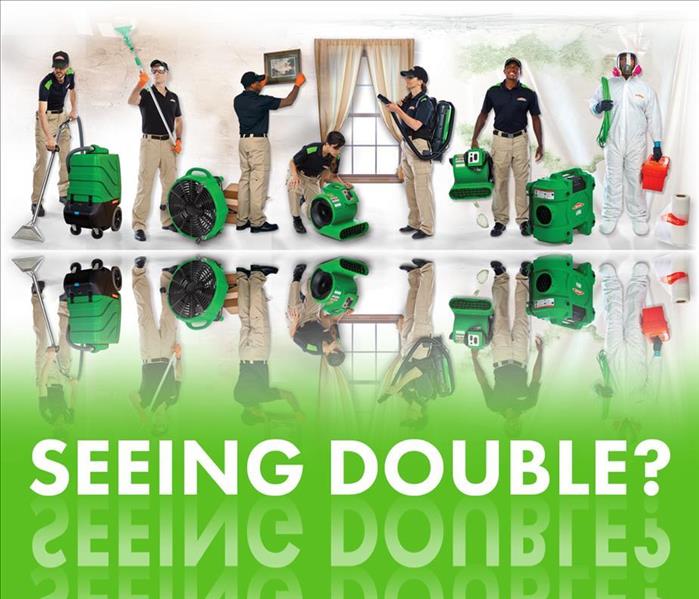 Storm Drains
Storm Drains
As severe weather begins to come into our region it is wise to understand the importance of keeping your storm drains clear! Storm drains can become clogged with leaves, sticks and other debris that are washed towards them with excess rain and heavy winds. If your storm drains become clogged that could lead to the flooding of your streets, yard and even your basement if not taken care of.
Here are some tips to help ensure that your storm drains will not become clogged.
- Keep a tight lid on your trash cans and recycling bins
- Pick up trash around your community
- Do not rack your leaves into the street
- Do not blow your grass clippings into the street
If you have stairs that lead down into your basement from the outside, it is VERY important that storm drain remain clear and unclogged ALWAYS. The drain is one of the most important to keep clear as that area will quickly fill up and eventually make way into your basement.
If you or someone you know experiences water damage from a storm, do not hesitate to call. We are available 24 hours a day 7 days a week, including holidays.
Is Your Name On The List?
4/12/2021 (Permalink)
 Hurricane Season 2021
Hurricane Season 2021
With hurricane season right around the corner, SERVPRO of St. Mary's and Calvert Counties wants to know if your name is on the list?!
FUN FACT: If you are named after the Greek alphabet then we can answer that question for you. No! Your name is not on the list. Say what?! Yep, this year the World Meteorological Organization has taken out all of the Greek alphabet names that typically are used once the hurricane season runs out of names.
Hurricane seasons official start date is June 1st but with the consecutive years of early tropical cyclones the National Hurricane Center will start storm forecast May 15th. Here is the list of hurricane names for the 2021 season.
- Ana
- Bill
- Claudette
- Danny
- Elsa
- Fred
- Grace
- Henri
- Ida
- Julian
- Kate
- Larry
- Mindy
- Nicholas
- Odette
- Peter
- Rose
- Sam
- Teresa
- Victor
- Wanda
Did you find your name?! If not here is the list for if all those names get exhausted.
- Adria
- Braylen
- Caridad
- Deshawn
- Emery
- Foster
- Gemma
- Heath
- Isla
- Jacobus
- Kenzie
- Lucio
- Makayla
- Nolan
- Orlanda
- Pax
- Ronin
- Sophie
- Tayshaun
- Viviana
- Will
Things To Know About Your Local Snow Forecast
12/16/2020 (Permalink)
 Snow!
Snow!
There are typically two types of emotions people have when it comes to the thought of snow. You either love it or hate it. But when it comes to the idea of snow, people typically have the same questions.
How many inches will we get?
Will it stick?
Will I be trapped inside?
Will I be able to drive?
All questions we hope that the meteorologist will be able to give us answers too. SERVPRO of St. Mary's County and SERVPRO of Calvert County would like to enlighten you about 6 things they learned from about Meteorologist when it comes snow forecasts from the weather channel while looking at the latest forecast.
- They typically are not able to predict precise snow totals beyond a couple of days
- Model Snowfall graphics are not necessarily a forecast
- The first snowfall forecast you hear a few days out will likely change
- Snow can be highly variable over short distances
- Timing, temperatures and winds matter
- It is important to pay attention to light snow, too
For more information about these 6 features check out The Weather Channel.
SERVPRO of St. Marys and Calvert Counties would also like to remind you that we have endless resources when it comes to Storm Damage. If our community gets hit with a natural disaster and your home or business is effect, give us a call! We will be sure to help you faster than the rest.
Preparing Your Home For The Winter
12/9/2020 (Permalink)
 Winter is coming!
Winter is coming!
Winter is coming quick and it is important not only you are prepared but your home is too. The last thing you want to do during the mist fridig cold is have a to deal with house maintence, so do it now!
Some important tips while preparing your home SERVPRO of St. Mary's County and SERVPRO of Calvert County want to point out to you are:
- Clean out your gutters
- Re-caulk any doors or windows
- Inspect your roof
- Clean out your chimney
- Make sure your insurance coverage is up to date
- Wrap/Seal off windows
- Reverse ceiling fans to push any heat on your ceiling down
There are many ways to ensure your home is prepared for the winter and completing the tasks in advance will allow more time to snuggle up on the couch with a warm blanket and hot cocoa.
As always, in you come to a situation and need our assistance do not hesitate to call!
Tropical Storm Eta & Topical Storm Theta
11/12/2020 (Permalink)
 Flood Watch!
Flood Watch!
Tropical Storm Eta made landfall in Florida (Southwest of Jacksonville) and continued to move North-Northeast at about 15 mph. As the storm continues to move, Southern Maryland and other Northern regions along Eta's path have been experiencing heavy rain and slight cold fronts.
According to WeatherBug, two to five inches of rain will fall this afternoon before the storm pushes off the Southeast Atlantic Coast. Flash Flood watches have been issued all over St. Mary's County! Be careful driving the next couple of days as many roads have been covered with water. Remember to always turn around and never try driving through! Most flood death occur while in a vehicle.
On the latest update record setting 29th storm of the 2020 Hurricane Season, Tropical Storm Theta is currently being located 455 miles of the Azores packing strong winds of 65 mph. According to WeatherBug, "Theta will turn eastwards within the next couple of days before turning northeastward and passing several hundred miles of Azores on Saturday and Sunday."
We Get There Faster Than The Rest
10/19/2020 (Permalink)
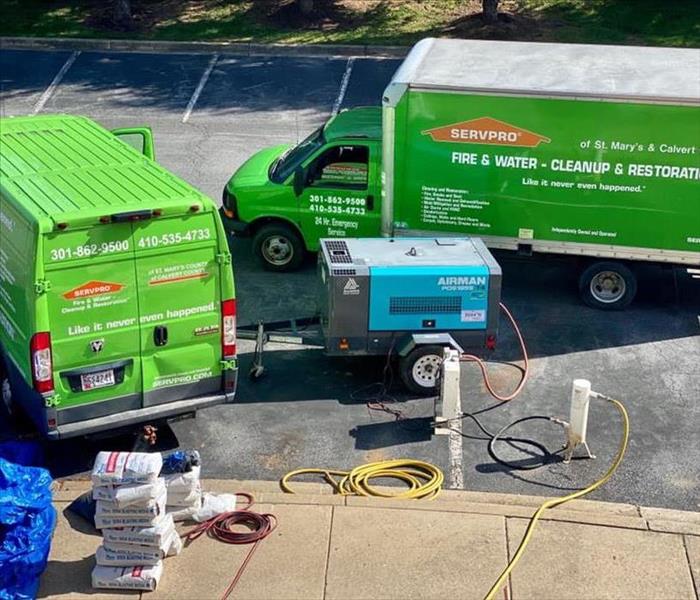 Call SERVPRO!
Call SERVPRO!
SERVPRO being the number one premier cleaning and restoration company in Southern Maryland comes with great responsibility to our customers in their time of need. Even under the highest amount of pressure and stress you will never have doubt we will be there faster to your disaster. When mother nature strikes, it is our time to shine. What separates us from the other Cleaning and Restoration companies is we are never alone. SERVPRO is a Family and when disaster strikes, we have the resources to handle any disaster no matter the size or volume. We would like to thank SERVPRO of Rockville/Silver Spring North, SERVPRO of Gaithersburg/Germantown, SERVPRO of Frederick County, SERVPRO of Washington DC, SERVPRO of Bethesda/Potomac and SERVPRO of Loudon County who sent multiple crews to Southern Maryland when Tropical Storm Isaias struck. When YOU call SERVPRO you won’t ever be alone.
Small Craft Advisory In St. Mary's and Calvert Counties
4/28/2020 (Permalink)
 Small Craft Advisory
Small Craft Advisory
When checking the weather via the news or internet often times there are alerts that run through a banner on the bottom of the screen with different advisories, watches or warning or show as alerts at the top the internet screen. Often times during the spring season you see an alert for a Small Craft Advisory and here in St. Mary's and Calvert Counties we are luckily enough to have our communities surrounded by water and the education behind this advisory is important.
According to the National Weather Service, a Small Craft Advisory is, "Sustained wind speeds or frequent gusts* of 20 to 33 knots (regionally defined**) and/or seas or waves 4 feet and greater and/or waves or seas are potentially hazardous due to wave period, steepness, or swell direction and/or waves in or near bars are hazardous to mariners due to the interaction of swell, tidal or river currents in relatively shallow water."
When a Small Craft Advisory is issued, it would be wise to avoid the water without the proper training and equipment. The Coast Guard recommends that boaters take precautions and to be prepared for whatever is thrown at them. The ocean, along with other bodies of water can be very unpredictable. Hazards can arise with little to no warning.
Worried A Freeze Warning Might Ruin Your Plants?
4/22/2020 (Permalink)
 National Weather Service Freeze Warning
National Weather Service Freeze Warning
Freeze Warnings are to alert you when there is expected to be significant and widespread freezing temperatures. According to the National Weather Service a Freeze Warning is issued in the spring at the start of growing (when it is late enough to cause damage to new plants and crops).
Have you recently planted new crops and/or plants and are worried that the upcoming Freeze Warning is going to damage them?
Check out this tips that could help protect your plants and crops from the frost:
- water the soil around them thoroughly the night before as wet soil holds heat better than dry soil
- lay a bed sheet, blankets, cloths or tarp over the plants but use material to keep them from coming into contact with the crop or plant
- Mulch can be used as a protective layer on the short plants but must be removed once danger has passed
- 100-watt outdoor lamp can be used to protect a small tree
Flash Floods In Prince Frederick, MD
4/13/2020 (Permalink)
 Turn around, Don't drown
Turn around, Don't drown
Did you know that flash floods are the #1 weather related killer in the United States? According to the National Weather Service, there are two key factors that relate to a flood. The first one being the rate of rainfall (intensity) and the second being how long the rainfall last (duration).
Flashfloods can occur within minutes or hours of rainfall and can cause the rolling of boulders, trees, destroy buildings, take out bridges and sweep up cars. It is important to know your areas floods risks and avoid those areas when there is heavy rainfall.
Never try and drive or walk through a heavy stream of water. It only takes as little as six inches of water to sweep you off your feet and two feet of water to uplift your car. If you see flood waters, turn around do not try and cross!
Listed below are the multiple different types of floods:
- River Floods: along rivers caused seasonally in winter and spring from rain and melting snow
- Coastal Floods: Tropical storms, hurricanes or intense offshore low pressure system driving ocean water inland.
- Urban Floods: land converted from woods or fields to parking lots and roads losing its ability to absorb rain water. Can lead to roads and streets becoming swift rivers and basements filling with deep waters.
- Flash Floods in Arroyos/Washes: Water carved gully or a normally dry creek-bed that can quickly become filled with fast moving water
- Ice Jam: Floating ice that stops the flow of water
Snowy Driving In St. Mary's and Calvert Counties
12/10/2019 (Permalink)
 A smart driver is a good driver!
A smart driver is a good driver!
Driving period can be dangerous and frightening to many and factoring in bad weather only makes it worse. According to research that was done by the AAA Foundation for Traffic Safety, more than 2,000 road deaths every winter are factored in by winter storms, bad weather and sloppy road conditions.
It is important every day when you are driving that you drive with caution and awareness especially when there is snow on the ground. We want everyone to get home to their families at the end of the day. Follow our snowy driving safety tips will help make that possible.
- If you are not comfortable driving in the snow, STAY HOME!
- Drive slowly and with caution. Accelerate and decelerate appropriately. There is no need to hurry
- Increase your following distance. Remember it takes longer to stop on ice or snow.
- Keep contact with your brake. Have your heel on the floor and ball of foot on the petal.
- Try to always be moving. Unless you have to stop try to maintain a low speed as it is harder to regain traction at a complete stop.
- Don't apply extra power as that will only cause your tires to spin
- Let go of gas when you are traveling downhill. Too much speed will make it harder to stop and easier to spin out.
- Don't stop going up a hill, you will get stuck.
A smart driver is a good driver. Be safe while driving and remember that your not only in the hands of your life on the road, but the others around you.
Need Ways To Lock In The Heat In Your Home Without Having Your Energy Bill Skyrocket?
11/13/2019 (Permalink)
 Are you trying to save money?
Are you trying to save money?
As the weather is getting colder on the outside, so is it on the inside. The days of opening a window to let the fresh air in are over and the days of wrapping yourself up in a cozy blanket on the couch are in. One day soon a blanket, jacket, scarf, hat, socks and whatever else you can find laying around the house to keep you warm will not be enough and you will have to turn the heat on higher.
Are you looking to save heat and fuel this winter and in turn save money!? Below of tips on how you can do just that.
- Take advantage of the heat from the sun. Open curtains during the day to allow the natural sunlight to heat your home and close them at night to trap the heat in
- Cover your windows with a clear plastic sheet on a frame or tape clear plastic film to the inside of your windows. Tight fitted drapes or curtains installed on your windows is a good option too.
- When you are home and awake set your thermostat to as low as comfortable. When you are asleep turn down your heat 10 to 15 degrees to save energy overnight.
- Seal any air leaks around utility cut-through for pipes, gaps around chimneys and/or unfinished spaces. Use caulk or weatherstripping for leaks around doors or windows
- If you have a fireplace:
- Keep damper closed unless a fire is burning
- If you don't use the fireplace, plug and seal the chimney flue
How To Save Water Damaged Photos
11/4/2019 (Permalink)
 Need helping saving important documents or photos after a disaster strikes!?
Need helping saving important documents or photos after a disaster strikes!?
After a major storm hits causing flooding in your home or office, your first thought is not couch or desk that is going to be damage but the pictures that hold special memories or files that contain important documents that are submerged under water. While it may seem like a hopeless cause to try and salvage them, following a few simple steps cause make it possible.
- Carefully lift the photos/files from the water and separate them so they stand alone.
- Gently rinse the photos/files in cold, clear water. Do not rub photos/files!
- Lay each photo/file on a dry non-inked paper towel, face-up. Change the paper towel every hour until the photos/files are dried. To avoid your photos/files from curling faster, dry them inside away from the sun or wind. You can also create a clothesline inside and hang the files from there.
- If you do not have to dry your photos/files right away, rinse all photos/files and stack them between wax paper and then put them in a zip lock bag in the freezer. Freezing your photos/files will allow you to properly defrost, separate and air dryer your photos/files.
- It is a good idea to have a fan circulating air where you are drying your photos/files to speed up the process.
When dealing with photos or files that have been damaged by water, it is important to remove them from the wet surfaces and to a dry area as soon as possible.
Damages books or files can often times linger a musty smell. If so, place them in a cool, dry place for a couple of days. If the smell is still present, place them in an open box, placed inside a larger closed container with an open box of baking soda which will absorb the smell.
Safety Precautions For Lightning Storms
4/26/2019 (Permalink)
The odds for getting struck by lightning are pretty low, about 1 in 500,000, but that does not mean you want to test your odds.
If you hear thunder roar, go inside. During a lightning storm you should consider the following:
- Avoid water; lightning can travel through a plumbing system.
- Avoid electronics; lightning can travel through electrical systems, as well as, radio and television reception systems.
- Avoid phones with cords
- Avoid concrete floors and walls; lightning can travel through any metal wires or bars in concrete walls or floors
Stay inside for at least 30 minutes after the last thunder has been heard.
If you are outside during a lightning storm and can not seek shelter; crotch as low as you can, with as little of your body touching the surface of the ground. Distance yourself from tall objects, such as a tree. You never want to stand under a metal pole or tree during a lightning storm! Those objects can act as a lightning rods. Lightning causes electrical currents along the top of the ground that can be deadly as far as 100 feet away.
Preventing Storm Damage To Your SOMD Home
4/24/2019 (Permalink)
Severe storms can come out of nowhere and we want your home to be prepared and protected for when they do. Preparing your home can be what saves you from having to deal with the cost of damage in repairs.
- Remove Dead Limber: Trim trees and bushes around your property to help prevent branches from falling onto your home from heavy winds. Be sure to remove the entire tree or bush if it is dead.
- Secure Outdoors Items: Tables, chairs, grills, decorations. High winds, rain or hail can damage or move your outdoor items. Bring them inside if you can or make sure they are secured to your home
- Drainage System: Clear out your gutters, drain tiles and pipes to allow the precipitation to flow properly off your home.
- Inspect Roof: Check for whole, cracks or loss ends that could be further damaged by the storm. Have repaired to avoid water from entering your home.
Allows be aware of the weather. It is better to take extra precautions in event of a storm rather than having to pay the cost of not.
Tornado Warning in St. Mary's and Calvert Counties
4/16/2019 (Permalink)
On Sunday, April 14th, the National Weather Service issued a Tornado Watch early evening leading into the dawns of the night and ending around 4am for many Maryland Counties. Around 2:45am, the Southern area of St. Mary's County Tornado Watch was turned into a Tornado Warning and residents were advised to take immediate shelter.
SERVPRO of St. Mary's and Calvert Counties urges the importance of knowing the difference between a Tornado Watch and a Tornado Warning and the precautions you should take.
Tornado Watch: Conditions are favorable for a tornado to develop
- Have a reliable weather source in reach to keep you updated on weather changes
- Have a plan of where and how you will take shelter
- Watch for changes in the weather. Green or orange sky and hail are tornado-friendly conditions
Tornado Warning: A tornado is in the area or radar indicates that a tornado is developing
- Take immediate shelter. Go to the lowest level in the building or safety shelter
- Stay away from windows and grab blankets/furniture to cover yourself to avoid being injured by flying debris
- If you are outside, find the lowest area like a ditch and lay face down covering your neck and head with your arms and hands. (Do not go under a bridge or overpass)
- Do not leave safety area until Warning is lifted
If your area is heading into the night with a Tornado Watch in affect, make sure you have a way to get alerts while you are sleeping. Have your phone set up to get emergency alerts and listen for the Fire Departments siren.
Is That Thunder You Hear in Southern Maryland?
4/12/2019 (Permalink)
With May being right around the corner, it is time to start preparing yourself for the season of thunderstorms here in Southern Maryland. While thunderstorm can happen at any time of the year, they are most common within in the months of May - August. A thunderstorm is considered severe when it contains one or more of the following: winds 57.5 mph or above, hail one inch or greater or a tornado. Here at SERVPRO of St. Mary's and Calvert Counties we want you to be safe during all storms!
Tips for Safety:
- When you hear thunder, go inside!
- Follow weather reports and warning signs
- Be prepared to change plans if weather permits
- Avoid windows, running water or using landlines phones
- Unplug appliances and other electric devices
- If necessary take shelter in a vehicle.
- Avoid flooded areas, fast moving water can knock you down and take you away
 SERVPRO's swift arrival and service can mitigate flood damage to your California property. We're Faster to any size disaster.™
SERVPRO's swift arrival and service can mitigate flood damage to your California property. We're Faster to any size disaster.™






 24/7 Emergency Service
24/7 Emergency Service

















